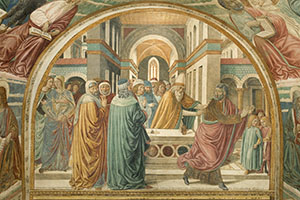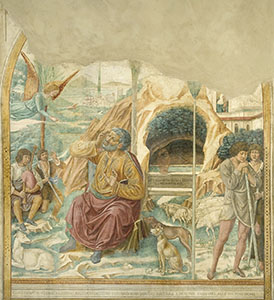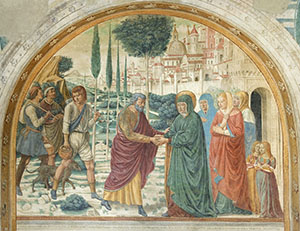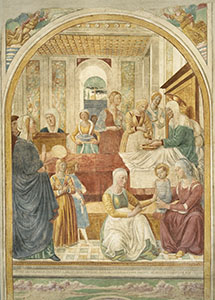
The Expulsion of Joachim, Tabernacle of the Visitation, Benozzo Gozzoli Museum, Castelfiorentino.

Joachim’s Dream, Tabernacle of the Visitation, Benozzo Gozzoli Museum, Castelfiorentino.

Encounter of Joachim and Anne near the Porta Aurea (Golden Gate), Tabernacle of the Visitation, Benozzo Gozzoli Museum, Castelfiorentino.

The Nativity of the Virgin, Tabernacle of the Visitation, Benozzo Gozzoli Museum, Castelfiorentino.
This tabernacle was frescoed by Benozzo Gozzoli with the assistance of his sons, Alesso and Francesco, as attested by a record from 1632 found in the Bishop's Curia in Volterra by the archivist Don Mario Bacci. The said document contains an inscription which once ran along the perimeter wall of the tabernacle, as read by Messer Cosimo Bindi, confessor of the nuns of Santa Maria della Marca: "This tabernacle, or Oratory, was commissioned by the Venerable priest Messer Francesco Gratia Prior of Castelnuovo di Val d'Elsa - who was endowed with lands and houses owned by of the Ven. Nuns and Convent of Santa Chiara in Castelfiorentino - this tabernacle, or oratory, is dedicated to the glorious Virgin Mary, Mother of Our Lord Jesus Christ, Redeemer of human nature and to save his soul and for use by those who wish to pronounce orations ... The painter was m° (Messer) Benozzo fior° (Florentine) and Franc° (Francesco) and Alfonso his sons. In M(CCCCL)XXXX on the 12th day of February..." (the work was, in fact, carried out in 1491 but, according to the Florentine calendar which until 1749 considered the start of the year to be the 25th March - the Catholic Feast of the Annunciation - the 12th of February was still 1490).
The issue of the names of his sons was thoroughly examined by the researcher Anna Padoa Rizzo with reference to the painter's cadastral documents. Benozzo fathered two daughters and five sons, two of whom practised the profession of painter: Francesco, born in 1469, and Alesso, born in 1473 and registered with the Florentine painters' Guild of Saint Luke.
Ser Cosimo Bindi, who declared in the record that the inscription was "very worn" and that he had therefore "made it out as best he could", probably interpreted the name "Alesso" as "Alfonso" which was very common in the seventeenth century, just when "Alesso" had fallen into disuse.
The frescoes depict episodes from the Life of the Virgin taken from the apocryphal Gospel of Pseudo-Matthew and the Gospel of St. Luke, arranged in two registers - one upper and one lower - and framed by painted architectural elements.
It is to be read starting from the inner wall with the lunette depicting Joachim Expelled from the Temple. Joachim is pictured offering incense to the Lord but is approached by the priest, Ruben, who turns him away from the temple, blaming him for his infertility. Indeed, according to Jewish tradition, being incapable of producing offspring was a sign of God's displeasure. This is followed, on the right-hand side, by a scene from the Dream of Jo achim, in which Joachim, filled with shame and crying, leaves the temple and, instead of returning home, goes to live with the shepherds and his flock a faraway land, leaving his wife, Anne, for five months without any word. While he is in the mountains pasturing the sheep, an angel calls on him to return home, revealing to him that, by the grace of God, Anne will conceive a daughter. Full of gratitude, Joachim offers an immaculate lamb in thanks, but then falls into a deep sleep. While he is sleeping, he has another vision of the angel which causes him, on awaking, to call the shepherds to him, who urge him to return to his beloved wife. Joachim therefore decides to return home. In the meantime, Anne, also visited by the angel, goes out to meet her husband. Anne is therefore depicted, in the upper register on the rear façade of the tabernacle, accompanied by her friends at the Porta Aurea (Golden Gate), embracing Joachim who has returned with his flock.
It could be hypothesised that the walled city depicted behind Encounter of Joachim near the Porta Aurea (Golden Gate) is identifiable with a view of Castelfiorentino from what is now Via Gozzoli where the tabernacle was originally situated. The painter is almost certainly transposing the celestial Jerusalem into the view of the real city. Indeed, the ancient walls that were once the entrance gates to the city, near the Elsa river, and the Church of St. Lawrence, distinguished by its brick construction, are recognisable. Unfortunately, certain architectural features are already unrecognisable in some surviving images of Castelfiorentino dating back to the sixteenth century. It should be noted, however, that the city's appearance changed during that century, with many of the Tuscan tower houses reduced in height. The dome of the church depicted here (which could invalidate this hypothesis since the dome of the church of St. Lawrence was not built until two centuries later) served, in any case, to identify the Holy Sepulchre in this double image of Jerusalem/Castelfiorentino and perhaps bears a visual resemblance to the dome designed by Brunelleschi for the Church of the Holy Spirit in Florence which Benozzo would certainly have seen several times. It was not unusual for painters to instil in their depictions of the Holy Land a kind of osmosis between elements of reference and actual, recognisable buildings, in order to reassure the observer. Indeed, the view of Arezzo which appears in the cycle of frescoes of the Legend of the True Cross painted by Piero della Francesca in that city's Franciscan Basilica is an important example of this practice.
The frescoes on the right-hand side of the tabernacle show the scene of the Nativity of the Virgin, in which Anne and Joachim have been able to conceive Mary, the new Eve and mother of the son of God. The narration then recommences anti-clockwise along the lower register, where frequent flooding of the Elsa river (which once ran not far from the tabernacle) has unfortunately damaged the paintings. Starting from the internal walls, beneath the arch, the frescoes on the left once depicted the Presentation of Mary at the Temple, where she remained until the age of fourteen when she was espoused to Joseph. The frescoes on the right illustrated the story of the Marriage of the Virgi n, of which only a few traces of the architecture above now remain.
The frescoes on the extrados depict the Annunciation of the Archangel Gabriel to the Virgin, in surroundings featuring fifteenth-century architecture, and those on the intrados show the Evangelists and the Doctors of the Church preaching the doctrine of Redemption.
On the right-hand wall, an elegant architectural perspective can be made out which must have served as a wing for the scene of the Visitation of Mary to Elisabeth, described by nineteenth-century sources. The narration then continues with the story of the Nativity of Christ (all that remains of which are a few fragments of the stable with the angels in glory above) and, on the left-hand side, the almost entirely lost Adoration of the Magi.
The iconographic programme was completed by a trompe l'oeil altarpiece (of the same design as the one still conserved in the Tabernacle of the Madonna of the Cough), where the Madonna enthroned with Child between the Saints Paul, Lawrence, Stephe n and Peter who are standing , with Saints Francesco and Claire kneeling was celebrated, as attested by several ancient sources.
In 1872, as a marble plaque declares, the Tabernacle of the Visitation, of which "time and the insults of man have destroyed the best part", was protected by the construction of a new chapel which completely encased it, in the hope of saving what remained of the paintings. At that time, the Italian Ministry of Public Education (the protection body before the institution of the Ministry of Cultural Heritage in 1975) handed over ownership of the tabernacle to the Municipality of Castelfiorentino.
This solution did not succeed, however, in solving the high humidity levels resulting from the frequent flooding and the precarious condition of the roof of the chapel built to protect the frescoes. It was therefore deemed opportune to remove them from the walls using the strappo (detachment) technique and carry out careful restoration. A few years later, the Tabernacle of the Madonna of the Cough underwent the same treatment.
The frescoes were stored in the Florentine Fine Art Superintendence and later placed in the Municipal Art Collection in Castelfiorentino Library. While the new exhibition returned Benozzo Gozzoli's masterpieces to the city and the general public, it also prevented correct viewing of the work. Indeed, the available exhibition space did not allow the tabernacle to be displayed at its full height and it was therefore presented dismantled into three parts. This operation was, however, a worthy and effective one since it brought these works out of storage where they had lain for many years.
In 2009, the Municipal Administration of Castelfiorentino decided to return this tabernacle to the collective in a more suitable setting, and it was therefore exhibited, together with the other tabernacle of the Madonna of the Cough, in the Benozzo Gozzoli Museum.
Serena Nocentini